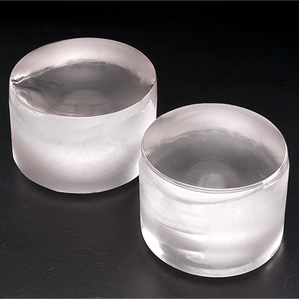
Posted on 03/20/2013 2:47:11 PM PDT by LibWhacker
Manufactured sapphire is incredibly strong and scratch resistant. Now falling costs and technology improvements could make it competitive with glass.
Gorilla Glass is great, but iPhone screens can still shatter.

Crystal clear: These unpolished, uncut boules of manufactured-sapphire crystal weigh 130 kilograms (left) and 100 kilograms (right).
Manufactured sapphire—a material that’s used as transparent armor on military vehicles—could become cheap enough to replace the glass display covers on mobile phones. That could mean smartphone screens that don’t crack when you drop them and can’t be scratched with keys, or even by a concrete sidewalk.
Sapphire, a crystalline form of aluminum oxide, probably won’t ever be as cheap as Gorilla Glass, the durable material from Corning that’s used to make screens on iPhones and other smartphones. A Gorilla Glass display costs less than $3, while a sapphire display would cost about $30. But that could fall below $20 in a couple of years thanks to increased competition and improving technology, says Eric Virey, an analyst for the market research firm Yole Développement. And since sapphire performs better than glass, that price could make it cheap enough to compete, he says.
Sapphire is harder than any other natural material except diamond; by some measures, it’s three times stronger than Gorilla Glass, and it is also about three times more scratch resistant. That’s why Apple uses it now to protect the camera on its iPhone 5. Virey says that all major mobile-phone makers are considering using sapphire to replace glass. “I’m convinced that some will start testing the water and release some high-end smartphones using sapphire in 2013,” he says.
An alternative to using pure sapphire is to laminate an ultrathin layer of sapphire with another, cheaper transparent material, maintaining much of the performance advantage of sapphire at a cost comparable to that of the glass typical in mobile-phone displays.
For this purpose, GT Advanced Technologies, based in Nashua, New Hampshire, is developing a method for making sapphire sheets thinner than a human hair—much thinner than the nearly millimeter-thick glass used now on mobile phones. (The technology, originally developed for making very thin solar cells, was acquired from Twin Creeks Technologies. See “Startup Aims to Cut the Cost of Solar Cells in Half.”)
GT is also cutting the cost of sapphire manufacturing by following the strategy that it used over the last several years to reduce the cost of making crystalline silicon for solar cells.
To make the sapphire, aluminum oxide is melted down in a specialized furnace and then allowed to slowly cool to form a large crystal. That crystal is then cut with a diamond-coated wire saw. GT designs its furnaces so that they can be cheaply upgraded to make ever larger crystals as the technology improves, allowing customers to increase production without buying new equipment.
GT is more optimistic about prices than Virey, estimating that sapphire displays might cost only three to four times as much as those made from Gorilla Glass. People at the company say prices will fall further as GT improves its furnaces, and as the manufacturers that buy those furnaces streamline their operations.
Several other companies with proprietary technologies are also lowering the cost of sapphire, including Rubicon Technologies in the United States, Monocrystal in Russia, and Sapphire Technology in South Korea. If costs can get low enough, these manufacturers may have a large market waiting for them. But they’ll have to continue to contend with the incumbent technologies—Gorilla Glass and similar materials offered by other manufacturers. This year Corning introduced a new version of the material that it says is about twice as resistant to scratches. It could be in products later this year.
Transparent Aluminum!!!

lulz
130 Kg sapphire? Where do I get a setting for a 650,000 karat stone?
LOL! Exactly!
Thanks LibWhacker.
Synthetic Sapphire? smaphire! I just bought a 91.91 carat natural black diamond. . . It's beautiful, but I'm damned if I can figure out what to do with it. It's a brilliant cut 1.125 inches in diameter. Up to about four years ago, it would have been the second largest black diamond in the world, second only to the Black Orloff. Today, it's not even in the running.
Disclaimer: Opinions posted on Free Republic are those of the individual posters and do not necessarily represent the opinion of Free Republic or its management. All materials posted herein are protected by copyright law and the exemption for fair use of copyrighted works.